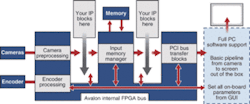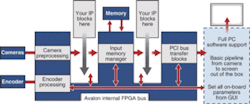FPGAs increase image-processing throughput
To increase the speed of image-processing algorithms, systems developers often need to use field-programmable-gate-array (FPGA).based add-in boards. Because of the throughput of such FPGA designs, they are often matched with high-performance image digitizers and I/O buses. One board, the Tsunami FPGA processor family from SBS Technologies (Albuquerque, NM, USA; www.sbs.com), can support a Camera Link interface and up to five EP1S25 FPGAs from Altera (San Jose, CA, USA; www.altera.com) on a 64-bit/66-MHz bus.
In the past, programming such boards has not been for the faint of heart, and it still represents a challenge. "Because the board is targeted at very-high-performance image-processing applications," says Brian Tithecott, director of sales and marketing, "it requires the programmer to be familiar with VHDL coding and intellectual-property (IP) blocks already written in VHDL."
Using the Altera Quartus compiler, VHDL can be developed for the board or built as block-level IP functions using Altera's system-on-a-programmable-chip builder. These tools are used in conjunction with the SBS Technologies Imaging Tool Kit (ITK) and the Altera Nios-configurable soft-core processor and an internal Avalon FPGA bus. In operation, the chip builder assembles image-processing functions into high-level image-processing blocks that are then linked together using the ITK for prototyping an application.
According to Tithecott, SBS Technologies is also exploring other ways the board can be programmed. One method uses the Platform Developer package from Celoxia (Abingdon, UK; www.celoxica.com) designed for system-level designers that wish to do evaluations using C-based programming in conjunction with FPGAs. Incorporating Celoxia's DK Design Suite base package with its Handel-C simulation environment and C-based synthesis, the software allows designers to develop functions in C-based design languages and implement them in FPGAs. This includes system codesign, coverification capabilities, C-to-RTL, and direct C-to-FPGA synthesis. "SBS is analyzing the product now and expects to offer a design around the technology very soon," says Tithecott.
"We are currently looking at a number of applications and how effectively these translate from C code to an FPGA implementation," he says. "Even if such code is only half as efficient as custom FPGA-tailored VHDL code, this will still translate into a speed-up greater than five times that of general-purpose CPU designs."

